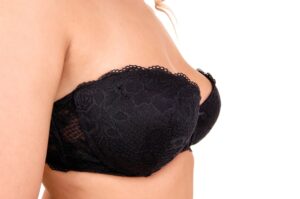 The “areolar complex” is a term that includes the nipple and the pigmented (dark) area around the nipple, termed the areola. The size of the areola varies widely from patient to patient. Patients frequently express concern about the size of the areola either being too large or too small. One aspect that is considered is the size of the areola in comparison to the breast size. If the breast is small, then a smaller areola appears in proportion. If the breast is large, then a larger areola appears in proportion. The average size of the areola is 35 to 45 mm in diameter. It is also very common for the areola to be asymmetrical—that is, the right and left areolas are not exactly alike. If the size of the areola is larger or smaller than this range, it is not an abnormality, but is considered an anatomic variation. Following pregnancy it is common for the areola to become larger as a result of the breast being engorged with milk. Once stretched from pregnancy, the areola may not return to pre-pregnancy size. While some women may have very little changes in the breast with pregnancy, this is the exception rather than the rule.
The “areolar complex” is a term that includes the nipple and the pigmented (dark) area around the nipple, termed the areola. The size of the areola varies widely from patient to patient. Patients frequently express concern about the size of the areola either being too large or too small. One aspect that is considered is the size of the areola in comparison to the breast size. If the breast is small, then a smaller areola appears in proportion. If the breast is large, then a larger areola appears in proportion. The average size of the areola is 35 to 45 mm in diameter. It is also very common for the areola to be asymmetrical—that is, the right and left areolas are not exactly alike. If the size of the areola is larger or smaller than this range, it is not an abnormality, but is considered an anatomic variation. Following pregnancy it is common for the areola to become larger as a result of the breast being engorged with milk. Once stretched from pregnancy, the areola may not return to pre-pregnancy size. While some women may have very little changes in the breast with pregnancy, this is the exception rather than the rule.
Patients frequently ask: “Can my areolas be made smaller?” or “Can my areolas be made larger?” The answer, in most circumstances, is yes. Making the areola smaller or larger can be done in conjunction with a breast lift or a breast reduction, or can be done as an isolated procedure. Making the areola smaller is commonly done during breast lift or breast reduction procedures. Prior to the procedure, the desired size and shape of the areola is discussed with the patient. In most patients, the nipple areolar complex remains attached to the breast and it is repositioned as it is reduced. If a breast lift or breast reduction is not needed or desired, then the areola size can be changed with a local procedure (just involving the areola). This procedure is termed the circumareolar or “Donut” procedure. In short, the size of the areola can be altered with multiple procedures to help reach the size desired by the patient.
If you are interested in areolar alteration and/or would like more information, we encourage you to schedule a consultation with Stephen Herring, MD. Dr. Herring is a Board-Certified plastic surgeon renowned for his personal approach to body contouring procedures—and he is happy to treat patients who live locally or who are traveling from out of town. Simply contact our office today..
Previous Post Next Post